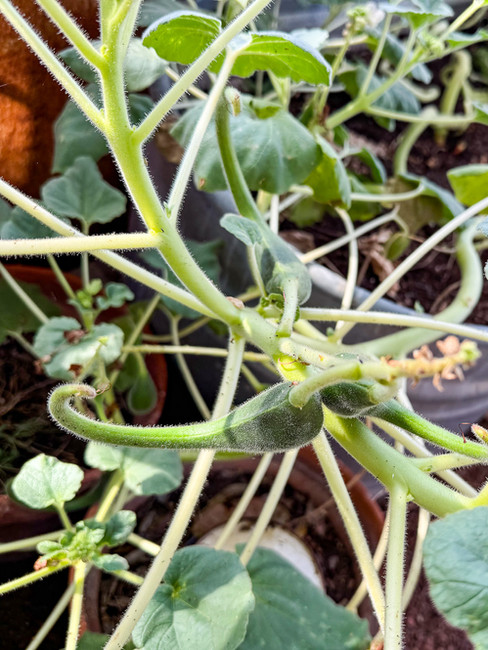October 2025
- STEAM Garden

- Nov 4
- 6 min read

October 2
I’m sorry we have to cover this host plant (Aristolochia fimbriata/White-veined Dutchman’s Pipe), but it is necessary to prevent this pipevine swallowtail from laying her eggs on the plant. Once again, we are running out of food for pipevine caterpillars even though we planted 75+ additional plants in spring. Once again, we are protecting our denuded plants so they can recover and grow new stems and leaves. If eggs were laid now, all caterpillars would die from a lack of food.

I stated in my August 30, 2025 entry that I’m raising more pipevine plants for next year. Well, we now have about 450 white-veined pipevine seedlings that we hope to protect and nurture through the winter. We have changed our goal! Next year we plan to have three times as many plants as we have now! I have a feeling we will never have enough to meet the demand. 😊
October 6
In spring of this year, I planted some antelope horn milkweed seeds in a large planter in the glass greenhouse next to my house. I was disappointed at the germination rate of the seeds I purchased, but these two large, healthy plants thrived! They are now producing seeds in their uniquely shaped pods! I am collecting and drying the pods so we will have fresh seeds to plant in spring. We are adding a large Milkweed Patch to our STEAM Garden in early 2026 and we need all the plants we can get.

This is white boneset, or white mist shrub, (Ageratina havanensis). In Zone 8b, it spends most of the year as a dense, leafy-green mounded shrub. It might bloom for a couple of weeks in late spring, but in the fall, it blossoms into a Cinderella plant supplying late-season nectar. White sweet-smelling flowers emerge hiding most of the foliage, and they are covered with pollinators – flies, gnats, beetles, skippers, native bees, moths, and butterflies. The first picture was taken on October 7 and the second is from October 22 of this year. This plant is easy to propagate from stem cuttings.
October 9
I am so happy we were able to obtain this beautiful butterfly chair for our STEAM garden. It is perfect for photographs! This large metal creation was designed by Mike Darling, a Comfort, Texas metal artist with help from his brother Joey Lavinghousez. The size and shape of the art allow a human body of any age to become the abdomen of the butterfly, and their raised arms become the antennae. Our Dinah Zike Academy team invite you to visit our gardens in Comfort, Texas, and take a photo!

I had to share this photo because in my September 20, 2025 post I mentioned the importance of having low-level, water receptacles available for frogs. Look at this little visitor in one of our above-ground mini-ponds (14”l x 10"w X 5”h). It is partially hidden by a large concrete garden ornament that is shaped like a frog. It looks like the gigantic inorganic frog is protecting the smaller organic one.

I spend a lot of time cutting things up for compost bins, earthworm bins, and to springle under plants in the garden. Banana and avocado peelings, comfrey plant leaves, toilet tissue tubes, cardboard egg cartons, packing paper, brown paper sacks, and wilted flower arrangements are just a few of the things that keep me busy using my kitchen scissors when watching TV at night.

I know this is my garden journal, but I had to share a photo of Dwight Yoakum. My two sisters accompanied me to his concert in Austin, Texas, and he was fantastic. He’s still got the moves and the voice. I’m not a big contemporary music fan, I don’t have a play list, but I thoroughly enjoy his music and have kept up with him for decades. It was a fun sisters' evening out in our hometown.

For several months, I’ve been understanding and appreciative of this garden spider (see August 2025). I know the importance of biodiversity and food chains, but currently this arachnid is greatly trying my patience. Today, I saw two Monarchs and a pipevine swallowtail neatly wrapped in fine silk and hanging in his web! I can’t bring myself to show the pictures of the Monarchs!

This is the larva of a rhinoceros beetle (Dynastinae), and it is NOT harmful to the garden. Adult beetles feed on sap, fruit, and nectar; they are not voracious eaters, but their larvae are! The larvae feed on decaying organic matter and they can be found in compost piles, rotting wood, decaying leaf piles, or in wood-chip mulch. Both adult beetles and larvae can be picked up for observation because they cannot bite or sting, and only male beetles have horns. They might look frightening, but they are beneficial.

Can you find the tobacco hornworm (Manduca sexta) in this photo? The green caterpillar feeding on this native tomato plant is well hidden. It is about four inches long and fat. At first sight, I thought it was a tomato hornworm, and it does eat tomato plants, but it is the larval stage of the Carolina sphinx moth. The adult moth has a large wingspan of 4” to 5”, and it feeds on nectar. We did not kill this caterpillar because we only saw one and it is not destroying our huge tomato plants. It is part of our garden biodiversity and can be beneficial -- the adult moth is a nocturnal pollinator and there are lots of predators that prey on these caterpillars.

We created a fresh new earthworm bin today using 2000 red wiggler composting worms (Eisenia foetida) from Uncle Jim's Worm Farm. I start a bin from scratch every two or three years instead of digging up worms from our well-established Nectar Patches. We will keep the bin warm in the greenhouse during the winter, and the worms will double in number over the next three months. It will be nice to have over 4,000 earthworms in the spring.

Luis is a fish whisperer! As I mentioned in the January 22, 2025 entry, we keep goldfish in all our large livestock water troughs and our garden fishponds to control mosquito larvae. This is a photo of Luis giving them a treat. These goldfish are conditioned to come to him when he taps on the trough and rewards them with commercial fish food. In-between treats, they are eating green algae, insect larva, frog eggs, tadpoles, and water snails.

Every day for the last week, we have had thirty to fifty monarchs visiting Nectar Patches 1 & 2. The Monarchs are passing through on their way south, and they are hungry. This year, the flowers of tall cosmos, fall asters, and porter weed plants have been some of their favorites.
What a joy to see twice as many Monarchs as we had last year. We added Nectar Patches 3 & 4 this year, and we are planting more nectar-producing perennials now. We hope to have even more food available for them next year.
October 28
In August, I ordered root cuttings of Bocking 14 comfrey plants. We planted them in pots and followed instructions carefully. After nearly three months, only three pots had plants emerging. Today, I decided to empty a couple of the other pots to see how many cuttings were sprouting under the soil. All of them were decaying or completely rotted. It is hard to believe, but we kept them too moist during drought! I have ordered 24 more cuttings because we want to grow comfrey plants in an old orchard to restore the soil, and we plan to use comfrey leaves as mulch and as a source of enrichment for our compost and earthworm bins.

A cold front dropped the temperature from nearly 90°F yesterday to 42°F this morning. All the ectothermic creatures in the garden are lethargic and sleeping late, including this bumble bee. Cold mornings are a perfect time to take up-close photographs of pollinators as they roost and await the Sun’s warmth. This bumblebee is pictured on a gigantic Blue Mist Shrub, or Blue Boneset (Conoclinium coelestinum) that is taking over Nectar Patch 1. Also, see information on our white mistflower shrubs in the October 7 entry. Both white- and blue-flowered shrubs are prolific nectar sources in the fall.



























Comments